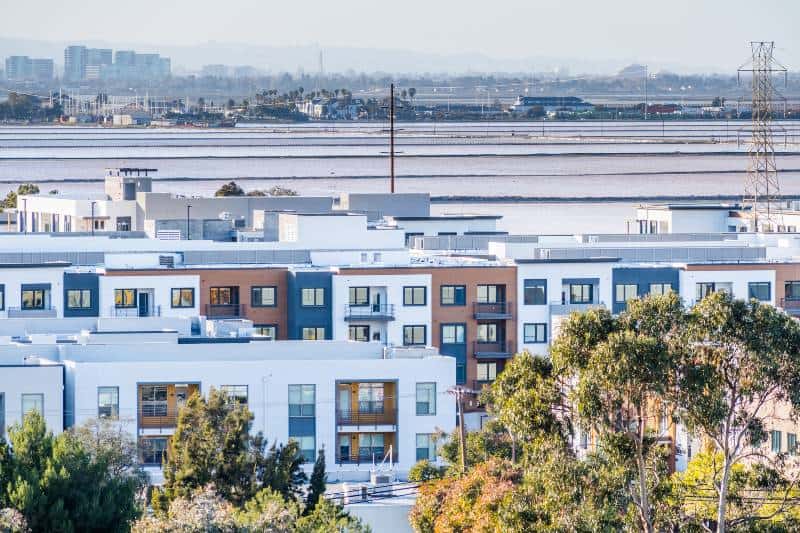The world of work has undergone a seismic shift, and we’re all feeling the tremors. Remember when the idea of working from home seemed like a distant dream? Now, it’s a reality for millions. This change isn’t just affecting our daily routines; it’s reshaping our cities, our homes, and the very buildings we work in.
For some, this shift has been liberating – no more long commutes or rigid office hours. For others, it’s brought new challenges – like finding a quiet corner to work in a busy household. And for those in commercial real estate? It’s nothing short of a revolution.
Let’s explore how this new world of work is changing the landscape of our cities and suburbs, and what it means for the future of office spaces. Whether you’re a remote worker, a business owner, or just curious about how our world is changing, there’s something here for you.
According to Regus research, 61% of workers are willing to switch jobs to obtain flexible working options, and 93% prefer companies that provide remote working opportunities.
Key Takeaways
- Remote work has decreased demand for traditional office spaces, driving companies towards flexible arrangements and smaller footprints.
- Co-working and shared offices have gained popularity, offering flexible, cost-effective solutions for remote workers and impacting the commercial property market.
- Property managers are adapting by repurposing spaces and integrating technology to meet hybrid work needs, ensuring relevance in the evolving landscape.
The shift in Commercial Property Demand
Decreased demand for traditional office spaces
The emergence and widespread adoption of remote work have had a significant impact on commercial properties, particularly in the demand for traditional office spaces. Numerous statistics and data indicate a noticeable reduction in office space needs as organizations embrace remote work arrangements.
For instance:
Reduced square footage: Many companies have downsized their office spaces or opted for flexible workspace solutions, resulting in a decline in the overall demand for traditional office environments. According to a survey Half of the largest international employers are planning to cut their office space in the next three years, according to a survey, as they struggle to manage the complex nature of the post-Covid workplace.
Vacancy rates: The reduced demand for office spaces is reflected in rising vacancy rates in commercial properties, highlighting shifts in the real estate sector. Landlords and property owners have encountered challenges in attracting tenants for traditional office spaces, leading to higher vacancy rates in many urban centers. This trend has been observed across various cities and regions, indicating a broader shift in the commercial property market.
The decrease in demand for traditional office spaces can be attributed to several reasons, with cost savings and increased flexibility being the primary drivers.
- Cost savings: Remote work allows organizations to reduce their expenses associated with leasing and maintaining office spaces. By adopting remote work models, companies can save on rent, utilities, office furniture, and other overhead costs. This financial advantage has become particularly evident during the COVID-19 pandemic when organizations sought ways to cut expenses and weather the economic uncertainties.
- Flexibility: Remote work offers employees greater flexibility in terms of their work location and schedule. This flexibility has become increasingly valued by employees who prioritize a better work-life balance. By embracing remote work arrangements, companies can attract and retain talent by offering flexible work options, reducing the need for dedicated office spaces.
To illustrate this shift in demand, consider the following examples:
- Many organizations have adopted a “hot-desking” approach, where employees do not have assigned desks and instead use shared workstations on an as-needed basis. This allows companies to reduce their overall office space requirements by maximizing the utilization of available desks.
- Co-working spaces have gained popularity as they provide flexible work environments and infrastructure for remote workers, freelancers, and small businesses. These shared workspaces offer cost-effective alternatives to traditional office leases, accommodating the evolving needs of remote workers.
- Virtual office solutions have seen an upsurge in demand, enabling businesses to have a prestigious business address and access to meeting rooms without the need for dedicated office spaces. This arrangement allows companies to maintain a professional image while reducing costs.
Remote work has led to a decreased demand for traditional office spaces, as evidenced by statistics, rising vacancy rates, and industry trends. The cost savings and flexibility offered by remote work arrangements have motivated companies to explore alternative workspace solutions, resulting in a shift in the commercial property market. Organizations have embraced strategies such as downsizing office spaces, implementing hot-desking policies, and utilizing co-working spaces or virtual offices to adapt to the evolving needs of remote work.
The emergence of alternative workspaces
The emergence of remote work has given rise to alternative workspaces such as co-working spaces, shared offices, and flexible arrangements, which have had a notable impact on the commercial property market. These alternative workspaces offer flexible solutions for individuals and businesses seeking a collaborative work environment without the commitment and expenses associated with traditional office leases. Here are some key points to consider:
- Co-working spaces: Co-working spaces have gained popularity in recent years, providing shared work environments where individuals from different companies and industries can work alongside each other. These spaces often offer amenities such as Wi-Fi, meeting rooms, communal areas, and access to networking opportunities. They cater to remote workers, freelancers, startups, and small businesses, offering cost-effective solutions, fitness facilities, and the benefits of a professional work environment.
- Shared offices: Shared offices, sometimes referred to as serviced offices or executive suites, provide ready-to-use office spaces that can be rented for short-term or long-term periods. These spaces are typically fully furnished and equipped with essential amenities, allowing businesses to move in quickly and focus on their core operations. Shared offices are particularly appealing to companies in need of temporary or project-specific office spaces, as well as those expanding into new markets or testing new business ideas.
- Flexible arrangements: Flexible workspace arrangements encompass various options that enable individuals and organizations to work in a manner that suits their needs, particularly in the context of the remote work trend. This can include remote work policies, flextime schedules, telecommuting options, and the utilization of virtual offices. Flexible arrangements empower employees to choose where and when they work, providing a better work-life balance and increased productivity.
The impact of these alternative workspaces on the commercial property market has been significant:
- Increased competition: The rise of co-working spaces and shared offices has introduced new competitors in the commercial property market. Landlords and property owners have had to adapt to this changing landscape by offering more flexible leasing options and enhancing the amenities and services they provide to attract tenants.
- Reconfiguration of spaces: Traditional office spaces have had to evolve to meet the demands of remote workers and flexible work arrangements. Some property owners have transformed underutilized office spaces into co-working areas, creating a mix of private offices, shared workstations, and communal areas. This reconfiguration allows property owners to cater to a broader range of tenants and maximize the utilization of their spaces.
- Collaboration and networking opportunities: Alternative workspaces foster collaboration and networking among individuals from different industries and backgrounds. Co-working spaces, in particular, often host events, workshops, and networking sessions, providing opportunities for professional growth and knowledge sharing. This aspect has attracted companies and individuals seeking to connect with like-minded individuals and tap into a diverse community of professionals.
- Economic growth in local communities: The establishment of co-working spaces and shared offices in local communities can contribute to economic growth. These workspaces often attract entrepreneurs, freelancers, and remote workers who support local businesses such as cafes, restaurants, and shops. This symbiotic relationship between alternative workspaces and local communities can revitalize areas and create a vibrant ecosystem.
The emergence of alternative workspaces such as co-working spaces, shared offices, and flexible arrangements has had a notable impact on the commercial property market, particularly in response to the hybrid work model.
These workspaces provide flexible solutions for individuals and businesses, offering a collaborative work environment without the commitment and expenses associated with traditional office leases.
They have introduced competition, triggered the reconfiguration of office spaces, and facilitated collaboration and networking opportunities. Additionally, the establishment of these workspaces can contribute to economic growth in local communities.

Adaptation of Commercial Properties
Repurposing of office spaces
The adaptation of commercial properties in response to changing market demands and the rise of remote work has led to a notable trend of repurposing office spaces. Property owners and developers have found innovative ways to transform underutilized or vacant office buildings into residential or mixed-use properties, revitalizing urban areas and meeting the evolving needs of communities. Let’s explore this adaptation further:
Conversion to mixed-use properties
Repurposing office spaces into mixed-use properties is another popular adaptation strategy. This approach involves integrating residential, commercial, and sometimes even recreational elements within the same building or complex. Successful examples of mixed-use conversions include:
- The Battery Park City neighborhood in Manhattan, New York City, transformed former industrial and office areas into a vibrant mixed-use community. The repurposed buildings now feature a combination of residential units, offices, retail spaces, parks, and recreational facilities, creating a dynamic and self-contained neighborhood.
- The Packard Plant in Detroit, Michigan, was one of the many casualties of the city’s industrial decline. However, today the deserted Packard Plant is far from lifeless. The property is currently being reimagined as a mixed-use development, a project that’s set to breathe new life into its glorious walls.
- The ambitious conversion plan includes a well-conceived blend of residential units, commercial spaces, art studios, and green spaces — all thoughtfully designed to cater to the needs of local residents. With these diverse offerings, it hopes to revitalize the area and for the Packard Plant to become a cornerstone of the community.
If you’re interested in this exciting transformation of a former manufacturing hub, you should check out my article, titled “The Key to Success with Mixed-Use Commercial Properties.” It’s an interesting and informative write-up about the opportunities and challenges of such projects, and what makes them so important for reviving urban areas.
These case studies highlight the successful adaptation of commercial properties through repurposing, bringing new life to existing structures, and meeting the evolving needs of communities. The conversions provide benefits such as:
- Urban revitalization: Repurposing office spaces can contribute to the revitalization of urban areas by transforming underused properties into vibrant, mixed-use communities. This revitalization attracts residents, businesses, and visitors, leading to economic growth and a more dynamic urban environment.
- Adaptive reuse: Repurposing office buildings promotes sustainability by utilizing existing structures and reducing the need for new construction. It maximizes the use of available resources and preserves the architectural heritage of buildings, blending the old and the new in innovative ways.
- Meeting housing demands: The conversion of office spaces into residential units helps address the increasing demand for housing, particularly in urban areas where land availability may be limited. It provides additional housing options, including affordable housing initiatives, and promotes diverse and inclusive communities.
The adaptation of commercial properties through repurposing office spaces has resulted in successful conversions into residential or mixed-use properties. These adaptations have revitalized urban areas, created dynamic communities, and met the evolving needs of residents and businesses.
Successful case studies demonstrate the potential for transforming underutilized office buildings into vibrant, sustainable, and inclusive spaces that contribute to the overall growth and development of cities.
Integration of technology and amenities
The proliferation of remote work has brought about significant transformations in the realm of commercial properties, necessitating a deliberate integration of technology and the provision of enhanced amenities to meet the evolving needs of businesses and individuals.
These adaptations have become paramount in ensuring that commercial properties remain attractive and relevant in the current remote work landscape.
In response to this paradigm shift, commercial properties have undertaken several initiatives, such as the implementation of smart office features and the upgrading of facilities, with the aim of accommodating remote workers and fostering a conducive work environment.
Implementation of Smart Office Features
Commercial properties have embraced the integration of smart office features, leveraging cutting-edge technologies to optimize operational efficiency and enhance the remote work experience. By incorporating Internet of Things (IoT) devices and automation systems, these properties have revolutionized their infrastructure, enabling seamless connectivity and intuitive control over various aspects of the work environment.
For instance, smart lighting systems equipped with occupancy sensors can automatically adjust lighting levels based on the presence of individuals, reducing energy consumption while providing a comfortable and well-lit workspace.
Similarly, climate control systems integrated with smart sensors can monitor and regulate temperature settings in real-time, ensuring an optimal work environment for remote workers.
These intelligent features not only contribute to energy efficiency but also enable remote workers to customize their workspace remotely, promoting productivity and well-being.
Upgraded Facilities to Attract Remote Workers
Recognizing the evolving demands of remote workers, commercial properties have proactively upgraded their facilities to offer a compelling and enticing work environment.
In this regard, high-speed internet connectivity has emerged as a fundamental requirement, prompting commercial properties to invest in robust internet infrastructure to deliver reliable and fast connections throughout their premises.
Moreover, recognizing the importance of seamless virtual communication, commercial properties have equipped meeting rooms and common areas with state-of-the-art video conferencing facilities and management software.
These include high-definition cameras, quality microphones, and large screens, enabling remote workers to engage in virtual meetings with colleagues, clients, and partners, replicating the collaborative dynamics of in-person interactions.
By providing these upgraded facilities, commercial properties aim to attract remote workers seeking technologically advanced workspaces that facilitate effective communication and collaboration, especially in a hybrid work model.
The impact of remote work on commercial properties has been profound, prompting a comprehensive integration of technology and amenities.
Through the implementation of smart office features and the upgrading of facilities, commercial properties have sought to cater to the unique needs of remote workers, emphasizing connectivity, comfort, and productivity.
By embracing these changes, commercial properties position themselves as attractive options for businesses and individuals seeking flexible work environments that align with the demands of remote work, ultimately contributing to a thriving and adaptive real estate landscape.
Regional Variances in Remote Work Impact
Urban vs. suburban areas
When considering the impact of remote work on different regions, it is essential to examine the variances between urban and suburban areas.
The shift towards remote work has led to significant changes in the demand for office spaces in these distinct locations. In urban areas, where office spaces were traditionally in high demand, there has been a notable decrease in occupancy rates as more companies embrace remote work options.
This decline in demand for office spaces in urban centers can be attributed to several factors. Firstly, employees no longer need to commute to city centers, reducing the need for office spaces in prime locations.
Additionally, the rising popularity of remote work has prompted companies to reevaluate their real estate strategies, potentially downsizing their office spaces or opting for more flexible arrangements such as co-working spaces.
As a result, urban commercial property markets have experienced a slowdown, with a surplus of vacant office spaces and declining rental prices.
Conversely, suburban areas have witnessed a different trend. The appeal of remote work has led many individuals and families to prioritize spacious homes in suburban neighborhoods, away from the hustle and bustle of urban centers.
This migration towards the suburbs has fueled an increased demand for residential properties, subsequently driving up real estate prices in the real estate sector.
Moreover, the shift towards remote work has also had a ripple effect on commercial property markets in suburban areas. With more individuals working remotely, there is a growing demand for local co-working spaces or satellite offices closer to residential communities.
This trend has presented an opportunity for the development of suburban co-working spaces, which can cater to the needs of remote workers who seek a dedicated work environment outside their homes.
Overall, the impact of remote work on urban and suburban areas is distinct, with urban areas experiencing a decrease in office space demand and suburban areas witnessing an increase in residential and potentially commercial real estate demand.
These regional variances emphasize the need for adaptability and flexibility in real estate markets, as businesses and investors navigate the changing landscape shaped by remote work preferences.
Global perspectives and trends
When examining the global perspectives and trends surrounding remote work, it becomes evident that the impact varies across countries and regions. Cultural, economic, and infrastructural factors play significant roles in shaping the influence of remote work on commercial property markets.
Firstly, cultural factors have a profound impact on the acceptance and adoption of remote work. Some countries have long-standing cultural norms that prioritize face-to-face interactions and physical presence in the workplace. In such societies, the transition to remote work may be met with more resistance, leading to slower adoption rates.
On the other hand, cultures that value work-life balance and flexibility may be more inclined to embrace remote work arrangements. For example, Nordic countries like Sweden and Finland have a strong focus on work-life balance, and this cultural perspective has made remote work more prevalent and widely accepted in these regions.
Secondly, economic factors significantly influence the impact of remote work on commercial property markets. Countries with high costs of living and expensive real estate markets may see a greater shift towards remote work as both employers and employees seek cost-saving measures. In these cases, remote work can provide an opportunity to reduce office space expenses and overhead costs.
Additionally, regions with a strong entrepreneurial culture may witness a higher proportion of remote workers as individuals seek the flexibility to work on their own terms. Conversely, countries with a robust traditional office-based workforce and thriving commercial property markets may experience a slower transition to remote work due to economic factors.
Infrastructure also plays a crucial role in determining the impact of remote work on commercial property markets. Countries with reliable and widespread internet connectivity, advanced digital infrastructure, and efficient transportation systems are better positioned to support remote work.
In such regions, remote work becomes more feasible and appealing, leading to potential shifts in demand for office spaces. Conversely, countries with limited internet access or inadequate digital infrastructure may face challenges in facilitating remote work arrangements, thus limiting the impact on commercial property markets.
It is important to note that these factors do not exist in isolation but interact with each other in complex ways. For example, a country with a strong entrepreneurial culture and affordable real estate may experience a significant shift towards remote work, despite potential infrastructural challenges.
Overall, when analyzing the impact of remote work on commercial property markets globally, it is essential to consider the interplay between cultural norms, economic factors, and infrastructural capabilities. These factors shape attitudes towards remote work and influence the demand for office spaces in different countries and regions.
Future Outlook for Commercial Properties
The future outlook for the commercial property market in light of the ongoing remote work revolution is a subject of interest for property owners and investors. While it is challenging to predict the exact trajectory, several potential long-term effects of remote work on commercial real estate can be identified, along with opportunities and challenges for stakeholders in the industry.
- Shift in Demand: The demand for traditional office spaces may continue to decline as remote work becomes more widespread. This could lead to a surplus of vacant office buildings in some regions, especially in central business districts while increasing demand for flexible workspaces in suburban areas.
- Adaptive Reuse: Property owners and investors may explore opportunities to repurpose underutilized office spaces into alternative uses that cater to changing needs. For instance, vacant office buildings could be converted into residential apartments, co-living spaces, or mixed-use developments with a blend of residential, commercial, and recreational elements.
- Rise of Co-working Spaces: As remote work gains prominence, the demand for co-working spaces may increase. Property owners and investors could leverage this trend by developing or partnering with co-working operators to provide flexible workspaces tailored to the needs of remote workers and small businesses.
- Location Priorities: The focus on remote work may lead to a reevaluation of location priorities. Rather than being confined to central business districts, commercial properties in suburban or non-urban areas may gain significance. Property owners and investors could explore opportunities to develop or acquire commercial spaces in these emerging locations.
- Technology Infrastructure: The reliance on remote work necessitates robust technology infrastructure. Commercial properties equipped with high-speed internet, advanced connectivity options, and smart technologies may be more attractive to tenants and investors, ensuring long-term viability and competitiveness.
Challenges:
- Potential oversupply of office spaces in certain regions, leading to decreased rental rates and reduced occupancy levels.
- The a need for property owners to invest in property upgrades and technology infrastructure to meet the demands of remote work.
- Uncertainty regarding the long-term viability of remote work, which may impact investment decisions and lease agreements.
Opportunities:
- Repurposing office spaces for alternative uses can generate new revenue streams and revitalize underutilized properties.
- The growing demand for co-working spaces presents an opportunity for property owners to collaborate with established co-working operators or develop their own flexible workspace models.
- Commercial properties located in emerging suburban or non-urban areas may experience increased demand, offering attractive investment prospects.
The future outlook for commercial properties in the context of remote work entails both challenges and opportunities. Property owners and investors who adapt to changing market dynamics, repurpose spaces, prioritize technology infrastructure, and identify emerging location preferences can position themselves for success in the evolving landscape of commercial real estate.

Impact of Remote Work on Commercial Properties FAQs
What is the impact of remote workers?
How does remote work affect the CRE market?
What are some global trends in remote work’s impact on commercial real estate?
What is the effect of remote working on company culture?
What impact has a remote way of working had on your productivity?
Conclusion
The remote work revolution has reshaped our professional landscape, presenting both challenges and opportunities for businesses and commercial property owners. It’s a lot to navigate, but you don’t have to do it alone.
As we’ve seen, adapting to this new reality is crucial for success. Whether you’re rethinking your office space, considering a move to the suburbs, or exploring ways to make your property more attractive to remote workers, I’m here to help.
Let’s chat about your unique situation and find the best path forward together. Schedule a call with me today, and let’s turn these challenges into opportunities for growth.




